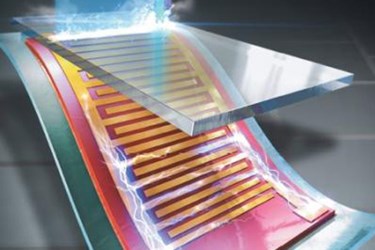Scientists Make Major Advancements In Nanogenerator Power Efficiency
By Joel Lindsey

Researchers at the Korea Advanced Institute of Science and Technology (KAIST) have developed a new manufacturing technique they say could dramatically improve the power efficiency of flexible nanogenerators, making it more feasible to use this type of power generator to fuel wearable and implantable medical devices.
“We were able to convert a high-output performance of [approximately] 250 V from the slight mechanical deformation of a single thin plastic substrate. Such output power is just enough to turn on 100 LED lights,” Keon Jae Lee, associate professor of materials science and engineering at KAIST and lead researcher on the project, said in a press release issued recently by the institution.
“Building on this concept, is highly expected that tiny mechanical motions, including human body movements of muscle contraction and relaxation, can be readily converted into electrical energy and, furthermore, acted as eternal power sources,” according to Lee.
While the use of flexible piezoelectric devices — which generate electric power from physical motion — is not a new concept, Lee’s team says it has devised a way of overcoming some of the problems typically plaguing the production of such devices.
In particular, poor energy efficiency and a complicated manufacturing process have posed the most significant challenges to creating viable piezoelectric nanogenerators.
To confront these difficulties, the research team developed a “robust technique to transfer a high-quality piezoelectric thin film from bulk sapphire substrates to plastic substrates using laser lift-off (LLO),” according to the press release. Through this process, the team was able to create a large-area thin film piezoelectric nanogenerator capable of turning physical motion into power at a rate almost 40 times higher than previous nanogenerators.
Results from early tests of the new power-generating device have been published recently in the journal Advanced Materials.
Researchers involved with the project are now turning their attention to building 3D stacks of flexible piezoelectric nanogenerators in the hopes of further increasing the potential power output with this new manufacturing technique.
Using tiny, flexible, piezoelectric nanogenerators as a way of powering wearable and implantable medical devices is a popular concept at the moment, with researchers around the world working to make this a more viable possibility.
Med Device Online, for example, recently reported on the efforts of researchers in the U.S. to develop tiny piezoelectric power generators that would convert the movements of beating hearts and breathing lungs into electricity to power pacemakers, defibrillators, and heart-rate monitors.
Image Credit: KAIST
